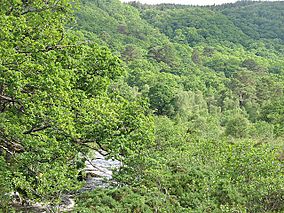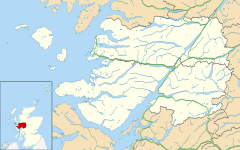Ariundle Oakwood facts for kids
Quick facts for kids Ariundle Oakwood National Nature Reserve |
|
|---|---|
|
IUCN Category IV (Habitat/Species Management Area)
|
|

Ariundle Oakwood
|
|
| Location | Strontian, Lochaber, Scotland |
| Area | 70 ha |
| Established | 1977 |
| Governing body | NatureScot |
| Ariundle Oakwood National Nature Reserve | |
Ariundle Oakwood is a special place in the Highlands of Scotland. It's located near the village of Strontian in an area called Sunart. The name "Ariundle" comes from a Scottish Gaelic phrase, Àirigh Fhionndail, which means "the shieling of the white meadow."
This amazing woodland is part of the ancient Sunart Oakwood. It's one of the last pieces of old oak forests that used to stretch all along the Atlantic coast of Europe. Because it's so important, Ariundle Oakwood was made a National Nature Reserve in 1977. This means it's a protected area where nature is carefully looked after.
The reserve is managed by an organization called NatureScot. They work with Forestry and Land Scotland to protect the trees and animals. Ariundle Oakwood is recognized as a special protected area because of its unique plants and wildlife.
Contents
Explore Ariundle Oakwood
NatureScot has created two easy walking paths for visitors to enjoy. You can start your adventure from a car park right near the reserve's entrance.
Walking Trails
- One path takes you through the northern part of the woods. You'll see the remains of an old croft (a small farm) and get great views of the hills.
- The other path explores the lower part of the woods, right next to the Strontian River.
You can even combine these two paths to make a longer walk, about 5 kilometers (3 miles) long. The main track through the reserve also leads to old lead mining sites further up the glen. It's also the starting point for a path up Sgùrr Dhòmhnuill, a mountain known as a Corbett.
History of the Wood
Ariundle Oakwood has a long and interesting past. You can still find signs of old settlements here. These include places where people made charcoal, old pony tracks, stone walls, and even "lazy beds" where potatoes were grown.
Ancient Settlements
The people who lived here long ago were called sluagh an torraidh bhain, or "the people of the white hillock." Their settlement was known as "Torban." Sadly, in the early 1800s, Torban was abandoned, and the land was used for sheep farming instead.
Charcoal Production
From 1752, the oak trees in Ariundle were very important. They were used to make charcoal for iron furnaces, like the one at Bonawe on Loch Etive. Charcoal was also used locally for the lead mining industry. To make sure there was always enough wood, the oak trees were "coppiced." This means they were cut back to the ground, and new shoots would grow from the stump. This is why many old oak trees here have multiple stems.
Managing the woodland for charcoal brought about a thousand workers to the area. But in the early 1800s, lead mining slowed down, and the Bonawe Furnace closed in 1876. After that, the woods were no longer needed for fuel. Instead, they became a sheltered place for farm animals.
Becoming a Reserve
In 1961, Ariundle Wood was first recognized as a Forest Nature Reserve. Then, in 1977, it became a full National Nature Reserve, giving it even more protection.
Plants and Animals
Ariundle Oakwood is a fantastic example of an Atlantic Oakwood. This type of forest is found in places with a lot of rain and mild temperatures, like the west coast of Scotland.
Trees and Plants
- The main trees here are sessile oaks and pedunculate oaks.
- Other native trees include holly, hazel, birch, rowan, willow, ash, and wych elm.
- There are also some Scots pine trees. Experts are not sure if these grew naturally or were planted long ago. NatureScot tries to help the native broadleaf trees grow more.
Ariundle is especially famous for its huge variety of tiny plants like mosses, liverworts, and lichens. Over 270 different kinds of lichen have been found here! This includes a very rare species called Biatora vernalis.
Wildlife
The wood is home to many different insects, including:
- caterpillars
- beetles
- dragonflies
- butterflies
- Over 200 types of moths
One very special butterfly found here is the chequered skipper. It's important on an international level! Other rare butterflies include the pearl-bordered fritillary and the small pearl-bordered fritillary.
Many birds also visit Ariundle, especially during migration. These include:
Larger animals you might find in the reserve include otters, pipistrelle bats, wildcats, pine martens, and badgers. It's a busy place for wildlife!
Images for kids
See also
 In Spanish: Reserva de la naturaleza nacional Ariundle Oakwood para niños
In Spanish: Reserva de la naturaleza nacional Ariundle Oakwood para niños



